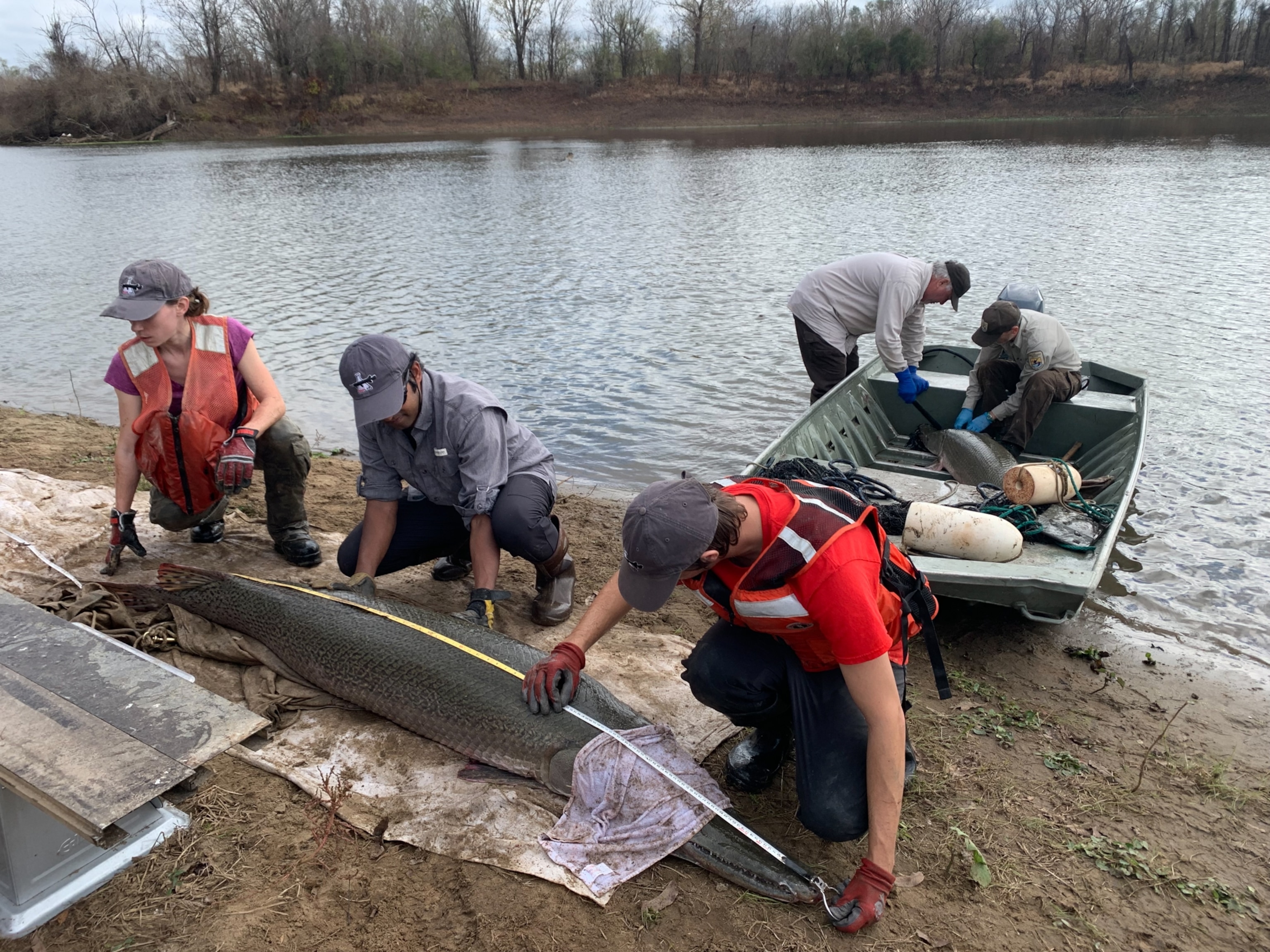
A new discovery could help save this 10-foot-long 'living fossil' fish
The alligator gar, an apex predator, has disappeared from parts of the Mississippi River.
The alligator gar is a snaggle-toothed fish longer than a park bench and heavier than a mountain lion. Bony scales covering its body make it look like an armored dinosaur, and for good reason: North America’s second-biggest fish has been thriving since the late Jurassic period, 157 million years ago.
Many don’t realize that the 10-foot-long alligator gar still exists, but when they do, their first thoughts often turn to fear, says Solomon David, a fish ecologist at Nicholls State University in Louisiana.
But “they’re not like alligators, lions or other animals that can tear off pieces of prey,” says David. “They have to swallow their prey whole, so they’re harmless to humans.”
Alligator gar, which can weigh more than 300 pounds, are like their namesake in one way: They’re apex predators, which means they provide critical ecosystem services to their home habitats—which is mostly the middle and lower Mississippi River watershed in the U.S. The freshwater species keep prey populations in check by hunting smaller fish, amphibians, reptiles, mammals, and birds, David says. (Learn more about freshwater fish.)
But their role as top hunter has earned alligator gar a bad reputation with anglers and even state wildlife managers, who sometimes tried to exterminate the animals, thinking they were competitors to game fish. In the 1930s, the Texas Game and Fish Commission even built a boat that discharged electric volts into the water. They called it the Electrical Gar Destroyer.
Combine those direct threats with habitat loss due to dam construction and floodplain draining, and alligator gar are now extremely rare in the upper river systems of America where they were once common. In some states, such as Ohio and Illinois, the species has disappeared completely and is considered locally extinct or extirpated. Alligator gar, found as far south as Central America, are more common in the southern parts of their range, especially in U.S. states such as Texas and Louisiana—which is why they’re listed as of least concern by IUCN.

“It’s a matter of scale. What might be of ‘least concern’ globally is definitely not the case on the local scale,” says David.
That’s why David and his colleagues are trying to reverse the fish's decline, for instance by breeding them in captivity and devising ways to learn more about the creatures without harming them. In a January study in the journal Transactions of the American Fisheries Society, David and colleagues showed that instead of cutting into the fish’s flesh to gather samples, taking small clips of fin can provide the same information.
“Just the sheer size of these animals blows you away when you're in their presence,” David says. “These are river giants.”
Fin clips, for the win
To protect gar, scientists first need to know basic information, such as where the behemoths roam and what they’re eating. To do that, they’d normally need to take a nickel-size sample of the fish’s tissue, which contains traces of elements scientists can use to track the fish’s whereabouts.
However, because gar have scales like medieval chain mail, the time-consuming and traumatic practice of extracting that amount of tissue can cause stress on the animal, says Thea Fredrickson, an aquatic biologist with the Lower Colorado River Authority in Texas.
“It can definitely be lethal. There’s no way around it.”
Fortunately, in their new study, Fredrickson and David have just proven that fin clipping is much easier on the gar.

“It also allows us to sample organisms repeatedly,” says David, who notes the fins grow back quickly. “Let’s say we catch the same fish a month or two later, or maybe a year later. We can see how that fish might be changing with its growth.”
“I found the results [of] the paper very promising,” says Zeb Hogan, a research biologist at the University of Nevada, Reno, who was not involved in the study.
Some alligator gars live to be 95 years or more, Hogan says, making each individual precious. (Read about Hogan’s quest to find the world’s biggest fishes.)
“We need to understand their biology and their ecology, but you don’t want to sacrifice a fish that’s that old or that grows so slowly,” says Hogan, who is also a National Geographic Explorer.
Though the fin-clipping technique has been shown to work for other fishes, no one had ever tried it with alligator gar. Now that it’s been proven, the scientists have already started using the technique at St. Catherine Creek National Wildlife Refuge in Mississippi.
In February, David and U.S. Fish and Wildlife Service and their gar biologist, Kayla Kimmel, caught numerous gar at the refuge, including a massive specimen longer than David is tall. They tagged the animals and captured 10 individuals to be used in a captive-breeding program at the wildlife service’s Private John Allen National Fish Hatchery. If all goes well, the offspring of these 10 fish will be reintroduced into U.S. areas where gar have disappeared.
Evolutionary wonders
There are seven species of gar found worldwide, and all have changed relatively little over time, which is why they’re known as “living fossils.” (Go underwater into the underlooked world of freshwater animals.)
“They found a body plan that worked, and they’ve stuck with it,” says David, explaining that the fish’s long, narrow shape allows them to lunge quickly at their prey.
Alligator gars can also breathe air, allowing them to survive in hot, low-oxygen environments, including brackish estuaries or even salt water.
Another useful adaptation? Poisonous eggs. Interestingly, alligator gar eggs don’t seem to be lethal to other fishes—only mammals, birds, reptiles, amphibians, and especially arthropods, such as crustaceans. This may mean they evolved the poison specifically to protect their eggs from crabs and crayfish, says David.
“But ‘don’t eat gar caviar’ is the take-home message for people,” he laughs
Save the freshwater giants
Freshwater megafauna, loosely defined as species that weigh over 66 pounds on average, are among the most endangered animals on Earth. Global populations have declined by almost 90 percent since 1970—twice as much as the loss of vertebrate populations on land or in the oceans, according to a 2019 study in Global Change Biology.
Large fish, such as sturgeons, salmons, and giant catfishes, particularly in the Northern Hemisphere, have experienced even higher declines, because of overfishing, pollution, and dams. (Read more about how dams in Southeast Asia are threatening megafish.)
This is why David is trying to change the perception of these animals any way he can. Sometimes it’s making gar puns on social media, and other times it’s testifying before the Minnesota Legislature in favor of a new bill that would provide gar and other so-called “rough fish” with some protections, rather than allowing them to be killed indiscriminately.
“It's a privilege to work alongside the growing number of conservationists garnering more respect for these charismatic megafish,” David says.
Of course, when he says “garnering,” the emphasis is on the gar.








